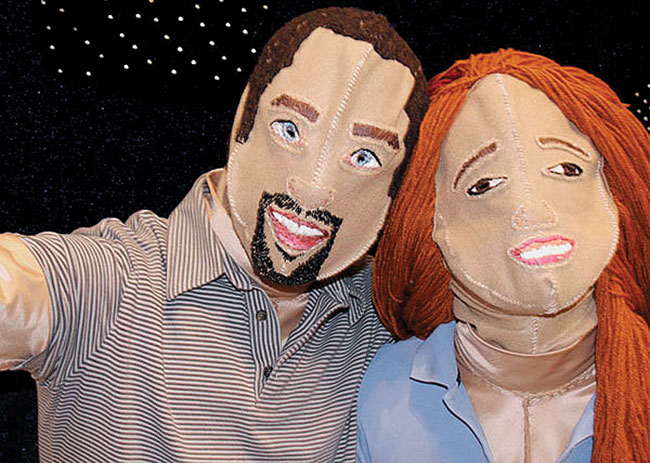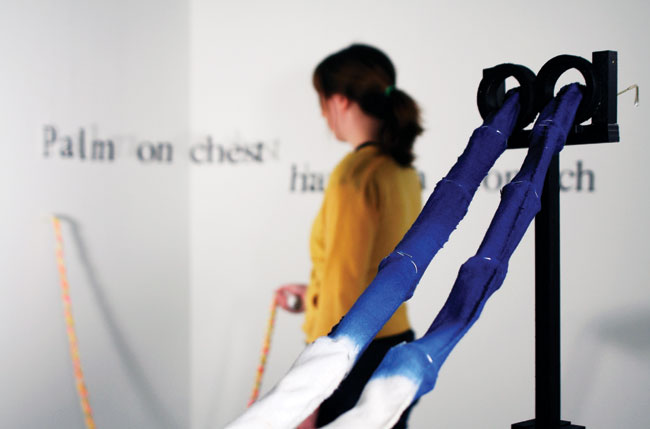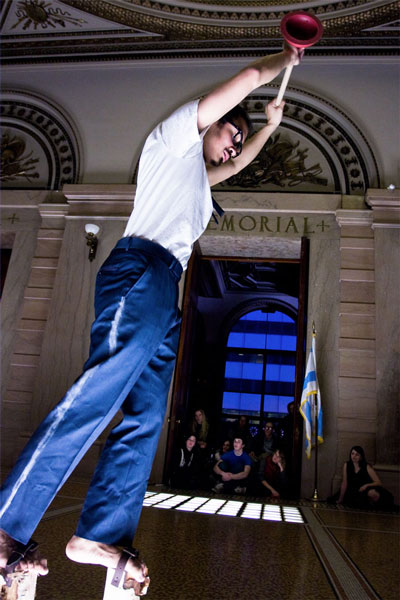A look at SAIC’s Student Union Galleries March exhibitions
Reviews by Paul David Young
Friends in Common

Playful, approachable and multivalent are the three best words to describe Cole Chickering’s “Friends in Common” at the SUGS LG Space in the Sharp Building. The inspiration for this solo show of new work was ignited when Chickering noticed a “random” friend on Facebook; he had never met this woman, but for some reason she was in his network — and even more importantly, she had a public profile. Intrigued, the artist decided to look a little closer.
Chickering thus had the opportunity to discover the most intimate details of the unknown woman’s life through the photos and comments that were posted for the entire world to see. The artist monitored her daily existence, or at least the life she lived on Facebook, and was witness to such milestones as the divorce she went through during that time.
A B.F.A. candidate with a focus in Fiber and Material Studies, Chickering was moved to translate this voyeuristic spectacle. He created felt masks and body suits, using them to re-create actual photos and a video from the content available on Jane Doe’s Facebook page. The original video depicts the couple dancing at their wedding reception, complete with a voiceover describing them “going out for breakfast, getting divorced and then getting a beer”.
Positioned on the walls of the show are images of the couple at what looks like a high school sporting event (complete with North Face jackets), in front of the Rainforest Café and having a good time at a party; below these recreational photos are albums containing the original images from Facebook. The show’s opening reception on March 18 was complete with one of Jane Doe’s favorite meals: appetizers from Bennigan’s.
When F spoke with Chickering about the show and its origins, he referenced artists, such as Kaari Upson, who work with found objects. Chickering works with found people. The indelible mark that Facebook has made on the landscape of human interactions is surely manifested in the fact that a person’s Facebook life can become the subject matter of a fine art exhibition.
Chickering states that his conception of the show isn’t necessarily “anti-Facebook” — he’s more interested in exploring and processing the large amounts of information we consume on a daily basis.
In choosing to use masks, Chickering said he was forced to think and interact with the content much more slowly than the way he would encounter it on the Internet. The handmade felt masks have a playful, almost comic quality to them, yet when regarded in the context of their explicitly voyeuristic origins, the concept of the project becomes more complicated.
The paradox of “Friends in Common” is that although the Facebook profile itself and Chickering’s interpretation of it ostensibly reveal something intimate, the very use of mask and costume suggest the idea of hiding something. The show as a whole is marked by these tensions, vacillating between the hidden and revealed, the tragic and the comic.
Are we to laugh at the banality of someone whose favorite food is the appetizers at Bennigans? Or should we cry for the loss of a relationship and its absurd tragic-comic portrayal in a public forum? Are the pictures of masked people at a party humorous? Or are they a kind of memento mori for a reality that we’ll never truly know? “Friends in Common” effectively straddles this continuum by displaying a life on display.
Anatomy of a Circle

For the exhibition “Anatomy of a Circle” in Gallery X in the Columbus Building, Tanya Fleisher, Sayward Schoonmaker and Soo Shin (all of whom are MFA students in the Fiber department) came together to develop a visual vocabulary built of text, video, fibers and ultimately, experience. Although the exhibition initially appears willfully obscure, particularly in comparison to the easy accessibility of “Friends in Common,” it merits an investment of time and quiet contemplation.
In a mustard yellow room, an obscure poetic text on the wall speaks of fountains, French bicycles and “Henry.” The esoteric nature of the text sets the tone of the show in general. This admitted work in progress interweaves multiple themes and characters that literally surround and encircle the viewer.
One of the most interesting elements of the show is the video projected from the ceiling onto the floor. Running over 50 minutes in length, it presents people performing strange, abstracted human interactions; the strangeness is intensified by the unusual angle of projection. All of the movements are somehow circular in nature, including a group alternately swaying and leaning into one another, juggling tennis balls, jumping rope, and hula hooping.
The show also contains two pairs of glasses connected with tubular fabric constructions, which allow two people to see one another when stretched out to the limit. A jump rope sits connected to the wall with one handle resting on the floor, while a projector from the floor broadcasts “wait” and “weight” as they ascend from a curved board in the adjacent corner.
At the show’s opening reception on March 16, a visitor referred to the movements in the video as a kind of “human Ouija board” — this may be a more fitting description of this show than they perhaps realized.
While at first glance the exhibition appears to be a disconnected assortment of objects without any identifiable meaning, the more the viewers engage with the objects on display, the more they get caught up in the riddles of relationality that the artists’ propose.
The show’s flier has a quote from Terry Eagleton about the materiality of poetry, and the way language creates a kind of texture: “It is true, even so, that all we literally have are words on a page. Reading these words as a poem means restoring to them something of their lost material body.” Keeping this quote in mind is helpful to navigate this fairly obscure show.
Also helpful to have in mind is the artists’ discussion of the circle as a kind of enigmatic icon, something so basic, so fundamental and yet impossible to obtain in a perfect form. Human interactions rely so heavily on it, whether a hug, a wheel for transportation or as a way of seeing. Thus, using the motif of the circle as a framework for navigation, the “Anatomy of a Circle” is really about the profound mystery of human interaction.







